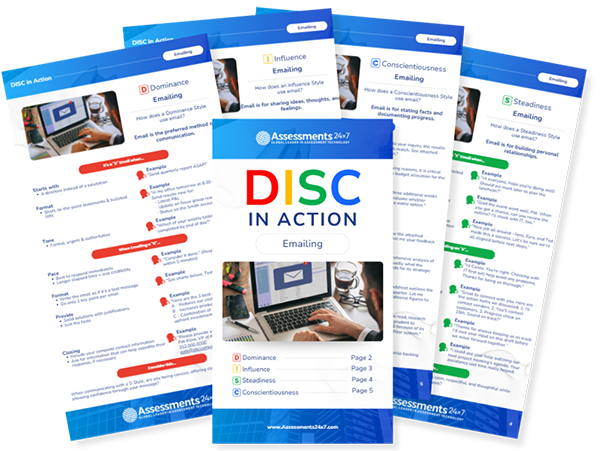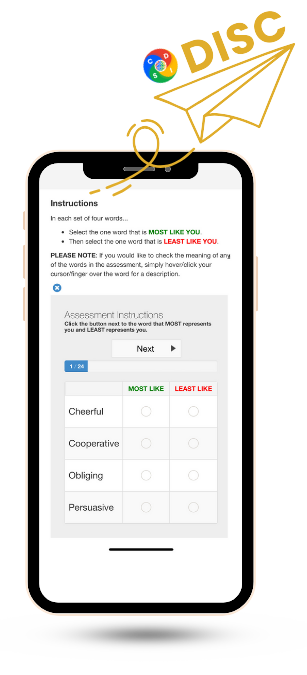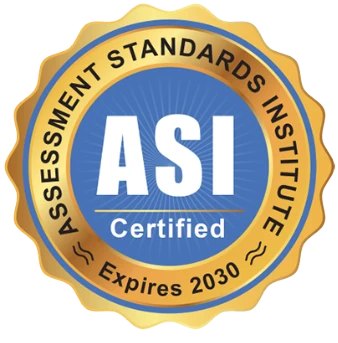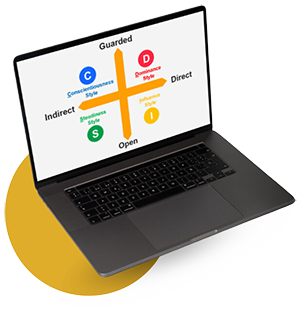What is DISC?
The DISC assessment is a leading tool in understanding human behavior, emphasizing observable patterns that affect teamwork, communication, and productivity. Taking a DISC assessment reveals insights into your personal DISC profile, highlighting key strengths and areas for growth. DISC categorizes human behavior into four main behavioral styles: Dominance, Influence, Steadiness, and Conscientiousness. Each individual possesses a unique behavioral style, helping explain approaches to communication, teamwork, and approaches to challenges.

What is the DISC model?
While many associate DISC with personality types, it actually focuses on distinct behavioral styles, helping people understand how their behavioral traits influence interactions and decision-making. The DISC model is widely used for professional and personal development.

DISC teaches users how to identify the predictable aspects of behavior and communication and to use that knowledge to their advantage. The ability to create a strong and immediate connection with others is a fundamental skill in sales, management, executive-level leadership, and everyday life. The goal of DISC is to help users build and maximize productive relationships. Users don’t need to change their personality traits; they need to recognize what drives and motivates others and determine the best ways to effectively interact with them. The comprehensive, yet simple, DISC reports teach users specific skills to improve their personal interactions that create immediate results.
What is the
DISC assessment
used
for?

DISC overview
The DISC profile is a simple, practical, and easy-to-remember model that focuses on
individual patterns of observable behavior and emotions. It measures the intensity of
characteristics using scales of directness, openness, pace, and priority to create a
unique blend of four behavioral styles:
- Dominance (D)
- Influence (I)
- Steadiness (S)
- Conscientiousness (C)
Using DISC can provide insight into behavioral tensions, causes of stress, problem-solving, and ways to respond more effectively to conflict. When these items are identified for each individual, it leads to better relationships, both personally and professionally. For example, salespeople using DISC can develop finely-tuned selling skills based on identifying and responding to a customer's style. In personal relationships, understanding the needs, emotions, and fears of others can help us build mutually-beneficial partnerships.

What does DISC stand for?
DISC represents the four styles of Dominance, Influence, Steadiness, and Conscientiousness. Each style provides insights into behaviors and priorities by analyzing responses to specific questions. While the four DISC Styles emphasize observable behaviors, they also relate closely to concepts like conscientiousness, reflecting a commitment to understanding and adapting to various communication styles. DISC offers insights into individuals’ unique patterns and identifies their main characteristics. Understanding DISC principles helps individuals grasp how different people interact and work, improving communication and collaboration within teams
What does DISC measure?
DISC measures observable behavior and emotions. It does not measure intelligence, education,
experience, aptitude, mental health, or values.
You may gain greater insight into how you respond to challenges, how you influence and
interact with others, how you operate at your preferred pace, and how well you follow
directions and function with structure in place, as well as many other patterns.
When you are aware of these dimensions and know how to apply them effectively, you can use
your style strengths or modify your style weaknesses to meet your needs and the needs of
others.
A DISC report has three parts:
Part I helps you understand each DISC style and identifies characteristics, including the
defining patterns of each behavioral style. The overview of the model is provided to help
you with a strong foundation of understanding in directness, openness, pace, priority, and
the emotions of each style.
Part II focuses on understanding your unique qualities and reveals insights that highlight
what sets your style apart. You’ll receive narratives and visuals that support your
understanding of your style as well as bullet-point lists including Communication Do's and
Don’ts, Your Workplace Tendencies, Potential Areas of Improvement, How You Respond to
Stress, and your 12 Behavioral Tendencies at Work. This section is all about you, and there
are several pages devoted to helping you achieve a deeper understanding of your style
blend.
Part III explores adaptability and offers actionable recommendations for you and others who
interact with you. This section is designed as a resource to assist you in communicating
more effectively with others and includes multiple tools to help you practice your new DISC
knowledge and guide your continued development and implementation in your everyday
environments.
How do DISC behavioral assessments work?
The good news about DISC assessments is that there are no right or wrong answers. They're
also simple to take online, with some assessments taking as little as 10 minutes to
complete.
Although a person’s Natural Style tends to stay fairly consistent over time, the Adapted
Style can change based on the environment, situation, or relationship and is a reflection of
a moment in time. Some may consider taking the assessment again several years apart because
the accuracy of the assessment itself is continually improved. Keep in mind, changes to
behavioral style can also occur due to seasons of life and emotional experiences. It’s
always a good idea to continue to evaluate your behavioral patterns to build awareness of
how you are responding to various situations, environments, and relationships.
Scoring and reporting can either be done electronically or in a few simple steps if you take
a paper version of the assessment.
Taking a DISC assessment involves answering a questionnaire about your own behavior by
choosing descriptors most like you and least like you. From your selections, an algorithm
returns your personal behavioral blend and your scores produce a profile report. You'll be
able to read about your unique behavioral style, your tendencies, needs, preferred
environment for greatest opportunities to be effective, and strategies for adapting behavior
appropriately with others. You will also learn more about your strengths and potential
challenges.
Reports also include insights about other DISC styles so you can learn more about how others
act and what their strengths and weaknesses are as well. When you do this in a work team
setting, you will end up with a greater understanding of your workplace colleagues to help
you with effective communication strategies going forward.
Some people are concerned that DISC profiles can place unfair labels on people. For example,
you might have heard someone dismiss someone’s action or comments with a remark like “She’s
a D, what do you expect?” Assigning labels and rationalizing poor behavior are not what DISC
profiles are about. Not all D styles behave or respond in the same way, especially when we
consider the style blend. A DC will behave differently than a DI, even though their primary
style is the same. DISC simply helps people better understand behavioral and communication
preferences and priorities.

DISC style overview

Dominance (D)
People with the D style place an emphasis on shaping the environment by
overcoming opposition to accomplish results. They are fast-paced and
task-focused.
A person with a D style…
- is motivated by winning, competition, and success
- focuses on accepting challenges, taking action, and achieving immediate results
- is described as direct, demanding, forceful, strong-willed, driven, determined, and self-confident
- may be limited by lack of concern for others, impatience, and stubbornness
- may fear losing control, being taken advantage of, or being seen as vulnerable; values competency, action, concrete results, and challenges
- values results and action, getting things done now
When communicating with D-style individuals, give them the bottom line, be brief and quick, focus your DISCussion, avoid making generalizations, refrain from repeating yourself, and focus on solutions rather than problems. Allow them to make choices and have control.

Influence (I)
People with the I style place an emphasis on shaping the environment by
influencing or persuading others. They are fast-paced and
relationship-focused.
A person with an I style…
- is motivated by social recognition, group activities, and networking
- focuses on spontaneity, collaboration, and expressing enthusiasm
- is described as convincing, charming, enthusiastic, charismatic, trusting, and optimistic
- may be limited by a lack of follow-through, impulsiveness, and being disorganized
- may fear loss of social approval, being alone or ignored; values spontaneity, dreaming, freedom of expression, and a variety of relationships
- values social acceptance and interaction, fun, and excitement
When communicating with I-style individuals, share your experiences, allow them time to ask questions and talk openly, and don’t get frustrated with a quickly moving, sometimes scattered conversation. Focus on the positives, avoid overloading them with details, and don't interrupt. Follow up in writing.

Steadiness (S)
People with the S style place an emphasis on cooperating with others within
existing circumstances to carry out the task in a steady and predictable
manner. They are slower-paced and relationship-focused.
A person with an S style…
- is motivated by cooperation, opportunities to help, and sincere appreciation
- focuses on collaboration, maintaining stability, and giving support
- is described as calm, patient, predictable, deliberate, stable, and consistent
- may be limited by being indecisive, overly accommodating, and an inclination to avoid sudden change without an opportunity to plan
- may fear sudden change, loss of stability, and offending others
- values loyalty, helping others, and security
When communicating with the S style individuals, be personal and amiable, express your interest in them and what you expect from them, take time to provide clarification. They may need some time to process. Be polite, and avoid being confrontational, overly aggressive, or rude.

Conscientiousness (C)
People with the C style place an emphasis on working meticulously within
existing circumstances to ensure quality and accuracy. They are slower-paced
and task-focused.
A person with a C style…
- is motivated by opportunities to gain more information and build their knowledge, show their expertise, and produce high-quality, accurate work
- focuses on ensuring accuracy, maintaining procedures and protocols, and challenging assumptions with evidence and data
- is described as careful, cautious, systematic, diplomatic, accurate, and tactful
- may be limited by being overcritical, overanalyzing, and isolating themselves
- may fear criticism and being wrong
- values quality and accuracy
When communicating with a C-style individual, focus on facts and details; minimize "pep talk" or emotional language; be patient, persistent, and diplomatic. C styles need time to process and respond so be sure to allow time for them to gather their thoughts and resources to formulate the best response they can offer.
Get Your DISC in Action Series
Five essential guides showing how each DISC style handles phone calls, emails,
change, boss relationships, and meetings. Ready-to-share
insights that make DISC practical and actionable for any workplace


How DISC assessments
are conducted
1. Questionnaire
Taking a DISC assessment is a quick self-assessment process that provides a
comprehensive report on your behavioral style. This assessment tool is a
valuable resource for both personal growth and professional development. You are
the expert on yourself, and there are no right or wrong answers. The online
questionnaire takes about 10 to 15 minutes to complete.


2. Scoring and
Analyses
The DISC assessment is scored electronically, and results are presented in a
comprehensive report. This report includes two primary graphs representing the
respondent’s Adapted Style and Natural Style, highlighting both situational and
instinctive behavioral patterns. The Behavioral Pattern View (BPV) visually
represents the intensity of each DISC style and indicates how styles combine to
form a unique behavioral profile, displayed in a circular graph for easy
reference.
This format provides insight into each individual’s style and enables meaningful
interpretation, especially helpful for coaches and facilitators. The report also
examines 12 Behavioral Tendencies, assessing how the respondent’s DISC styles
combine to influence areas like decision-making, communication, and stress
responses. This detailed approach allows individuals to gain a nuanced
understanding of their behavior and adapt effectively in varied contexts.
3. Feedback
Upon completing the DISC assessment, you’ll receive a personalized report that
highlights both your primary DISC style and a blend of behavioral patterns. This
report provides valuable insights into your natural interactions and adaptive
behaviors, enhancing your self-awareness and fostering stronger personal and
professional relationships. You’ll gain practical recommendations for enhancing
communication and adapting to the DISC styles of others, ultimately fostering
more productive personal and professional relationships. The feedback is
designed to be clear and actionable, enabling you to implement meaningful
changes that strengthen connections with colleagues, clients, and peers.


4. Application
Using DISC theory as a foundation, individuals and teams can develop strategies
to adapt behaviors, improve communication, and foster collaboration. Applying
this knowledge can significantly improve interactions by helping you adjust your
communication to the preferences of others. In team environments, recognizing
each member’s DISC style can streamline role assignments and optimize
productivity by matching tasks to individual strengths. DISC’s applications
extend across diverse areas, proving valuable in both professional and personal
settings.

DISC Assessment applications include:
- Hiring & Selection using Benchmarking - Empowers HR teams and managers to evaluate candidates against performance benchmarks, facilitating better hiring decisions.
- Change Management - Equips teams with strategies to manage behavioral adjustments, fostering openness and acceptance.
- Coaching - Provides tools to help individuals unlock their potential, enhancing guidance and support.
- Conflict Resolution - Improves clarity, empathy, and rapport between individuals with different behavioral styles.
- Customer Service - Guides service teams in consistently delivering high-quality interactions that are responsive to various styles.
- Leadership Programs - Using DISC insights, leaders can develop a more adaptable leadership style that resonates with each team member’s unique behavioral preferences.
- Management Skills - Builds managers' ability to genuinely engage, inspire, and challenge their teams.
- Mentoring - Provides insights to support the development of high-potential employees and fast-trackers.
- Sales Training - Enhances revenue by equipping sales professionals with tools to understand and adapt to customer preferences.
- Team Building - Assists in creating cohesive teams based on complementary strengths, with insights to address gaps as needed.
- Productive Meetings - Helps plan meetings that incorporate DISC styles for optimal outcomes and engagement.

5. Continued
Learning
The DISC assessment is a starting point for ongoing development and
self-awareness. Regularly revisiting your feedback report strengthens your
understanding of your behavioral patterns and provides an opportunity to refine
your interpersonal skills. Participating in DISC workshops, training sessions,
or getting DISC
certified can help deepen your
practical knowledge and
implementation. Sharing your DISC report with your team can open lines of
communication, promoting stronger collaboration and mutual support. Leveraging
DISC tools and resources supports continued growth, enabling you to build on
your strengths and develop adaptive communication techniques.


DISC Assessment Sample Reports
Click on the links for each assessment below to view each sample report. Note that the foundations of the reports are the same: each DISC assessment begins with the DISC Self report, and the Leadership, Sales, Service, and Coaching reports provide a specific appendix for each focused content area to help you apply DISC.
Describes "you" based on your observable behavior and can provide insights for others regarding your communication preferences as well as how you will likely interact with and respond to them. This self-perception report allows you to observe and evaluate your behavioral responses in various environments. By exploring your behavior and communication in a variety of environments, situations, or relationships, you can determine the most effective communication strategy or course of action to take with others.
After the DISC Self portion of the report, this report provides simple, practical tools to help use DISC as a leader in Developing, Adapting, Helping, Motivating, Complimenting, Counseling, Correcting, Delegating, & Acknowledging.
This report uses individual assessment data to provide information about your sales priorities and preferences. You’ll also learn how to connect better with customers whose priorities and preferences differ from yours through the five stages of the selling cycle – Connecting, Assessing, Solving, Confirming, and Assuring.
This helps you to understand how you can use your strengths and improve upon your weaknesses to improve customer service in your organization by communicating effectively in the service process – Greet, Value, Ask, Listen, Help, Invite.
Coaches really enjoy helping people, and this report helps determine how you can best provide this type of mentoring based on your strengths and skills and the interactions you have with others. DISC Coaching focuses on 5 ways to mentor and support others - Ask, Listen, Coach, Praise, and Challenge.
By combining DISC and Motivators, you can not only apply what you’ve learned about your behaviors and emotions but also align them in ways that reflect what matters most to you (your motivations). This combination report allows users to evaluate how their behavior is in alignment with or in a position of tension against their core values and motivational drivers.
An interactive program that trains, tracks, monitors, and measures every student in real-time to give a deeper, more comprehensive foundation of DISC through a video series. This program can be re-visited by each user repeatedly as necessary to keep the information fresh and accessible at any time.


Cornerstone Principles of a DISC Workplace

All DISC styles are equally valuable, and everyone is a blend of all four styles.

All DISC styles have unique strengths and challenges and no one style is better than another.

Your work style is also influenced by other factors that are not measured by DISC, such as life experiences, education, Motivations, Emotional Intelligence, and maturity level.

Understanding yourself better is the first step to becoming more effective when working with others.

Learning about the DISC styles of other people can help you understand their priorities, needs, and fears and how they may differ from your own.

You can improve the quality of your workplace interactions by using DISC to build more effective, mutually beneficial relationships.

Our reporting, research, and validation
Assessments 24x7 maintains the highest standards of development and application through
extensive research, and we diligently work to validate and ensure our reports are accurate.
Each report is designed to provide clear interpretations and feedback based on the
individual’s self-perception score that is then confirmed with face validity (to ensure the
assessment measures what it says it will measure).
We also practice a philosophy of transparency and openly share our rigorous reporting,
research, and validation information to ensure a high degree of confidence for use in
business, non-profit, coaching, or counseling. Our research reports are publicly available
here.
Which DISC profile or vendor is best?
The assessment industry is largely unregulated, and DISC is what's termed “open-source
research.” This means anyone can produce an assessment and call it a DISC profile. As a
result, the scientific accuracy of DISC profiles varies widely. We recommend only
considering DISC profiles that have published validity & reliability studies. Even among
providers with validated DISC profiles, the scope and quality of the reporting can
differ greatly. So, we recommend narrowing one's search to validated DISC profiles only,
then
comparing those providers’ sample reports. Other important considerations include:
- What is the technology provided by the DISC profile provider to purchase, deliver, and manage the assessments?
- Which validated DISC profile providers offer certification programs that are independently recognized and accredited by continuing education institutions like ICF, SHRM, HRCI, and ATD?
- What are the DISC profile costs?
- Are DISC profile team reports and trainer materials included?
Another consideration could be how to differentiate yourself from other coaches or professionals with the product. For example, you can take your career to the next level by becoming a Certified DISC Practitioner. At Assessments 24x7, becoming DISC Certified is just one of the many development options offered.
Lastly, examine the other programs and assessments available to support your clients and customers. At Assessments 24x7, our Core Assessment certification programs include DISC, Motivators, and Emotional Intelligence, and our diverse suite of over 25 assessments covers behavioral, thinking, and learning styles; emotional intelligence; company culture; and more.
DISC assessment pricing and more information
Assessments 24x7’s DISC system has multiple products and services available for purchase.
These include: Assessments and Profiles, Facilitation Kits, Group Reports, Starter Packages,
Continuing Education Credits (ICF, SHRM, HRCI and ATD),
Books, Training Tools, Certification Options, and more.
There are also ready-to-teach DISC workshops available for those who want to have a complete
solution to training DISC in a variety of contexts including: Self-Awareness &
Communication, Transitioning from Peer to Leader, Trust-based Leadership, Making Teams Work,
and Sales Optimization.
To find out more about our pricing, including wholesale pricing information,
contact us by calling +1 (206) 400-6647 or
send us an email
at sales@assessments24x7.com.
Frequently asked questions
How long does the DISC assessment take?
In most cases, it takes 10-15 minutes to complete the questionnaire.
When you begin the assessment, you will make 30 selections of the words or phrases that are
most like you and the words or phrases that are least like you. From these choices, the
report algorithm determines the balance of your DISC blend and returns the comprehensive
report tool.
It is important to note that not all vendors will have the same DISC assessment process.
Some offer computer adaptive testing with up to 80 questions, and others provide a 28-item
forced-choice questionnaire.
Because DISC is not a copyrighted model, vendors are free to use their own process. However,
there are only a small handful of valid, scientifically-backed versions of DISC assessments
out there. Be sure you examine the validity of the tools and pay special attention to the
last time the data was validated.
Can you fail a DISC assessment?
A common misconception about DISC profile tests is that you can pass or fail them. Unlike
traditional tests, there are no right or wrong answers in DISC. It is a behavioral inventory
that measures your natural and adjusted behavioral styles.
Can DISC be integrated with other personality assessments?
Yes, DISC can work with other personality tests. Combining them provides a fuller view of a
person's traits. It might help in understanding different aspects of behavior and
preferences. Although DISC focuses mainly on behavior, using it alongside other assessments
gives a more rounded insight into a person's characteristics. This approach can be useful
for personal growth, team development, and leadership training.
How often should I retake a DISC assessment?
Retake a DISC assessment every few years. Your behavior and preferences can change. Taking
the assessment again ensures accurate and current results.
Is DISC used to measure personality traits?
No, the DISC assessment does not measure personality traits in the traditional sense. Rather
than assessing personality traits, DISC focuses on observable behaviors and communication
styles, helping individuals understand their tendencies in various interactions and
environments.
Who created DISC?
Dr. William Moulton Marston was a lawyer and physiological psychologist who first introduced
the DISC model in his 1928 book Emotions of Normal People. A man of many talents, Marston
was also credited with helping to develop the first polygraph test, creating the character
Wonder Woman, and authoring several self-help books.
Marston conducted research on human emotions and, based on those findings, postulated that
people illustrate their emotions using the behavior types of Dominance (D), Inducement (I),
Submission (S), and Compliance (C), or DISC for short.
Marston did not create an actual assessment tool from his theories, but based on his work,
others did. In 1956, Walter Clarke, an industrial psychologist, first constructed an
assessment that confirmed Marston’s theories. He created the Activity Vector Analysis, a
psychometric tool that was designed for use by businesses to help them choose qualified
employees.
In 1965, DISC findings were published in the Journal of Clinical Psychology. The test format
continued to evolve when a "Self-Description" test forced respondents to make a choice
between two or more terms.
While the assessments used today have evolved from the original work of Marston and Clarke,
the same premise of four behavioral styles is used as the foundation and the continued
development of the DISC tool.
Understanding the history of DISC, from Marston’s theory to its modern application,
underscores its reliability as a behavior-based tool for personal and professional
development.









